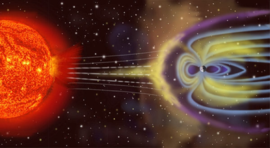The Earth’s space environment during disturbed solar conditions: a Space Weather’s challenge Aurélie Marchaudon
le 29 sept 2017 de11h00à 13h002017/09/29 2017/09/29

The upper terrestrial atmosphere is composed of two coexistent media: the neutral thermosphere and the ionized ionosphere. This complex region is often considered as the last link in the Sun-Earth chain of processes. It is gaining a renewed interest since a few years, thanks to the increasing societal challenges represented among others by GNSS communication, HF radio waves propagation, which are known to be largely altered by solar disturbances. The purpose of this seminar is to present the different types of solar perturbations, how they propagate in the interplanetary medium and how they affect the magnetosphere and the ionosphere-thermosphere system. Finally, the societal consequences of these solar perturbations, as well as the different scientific research topics currently followed to better understand this environment will be presented.




